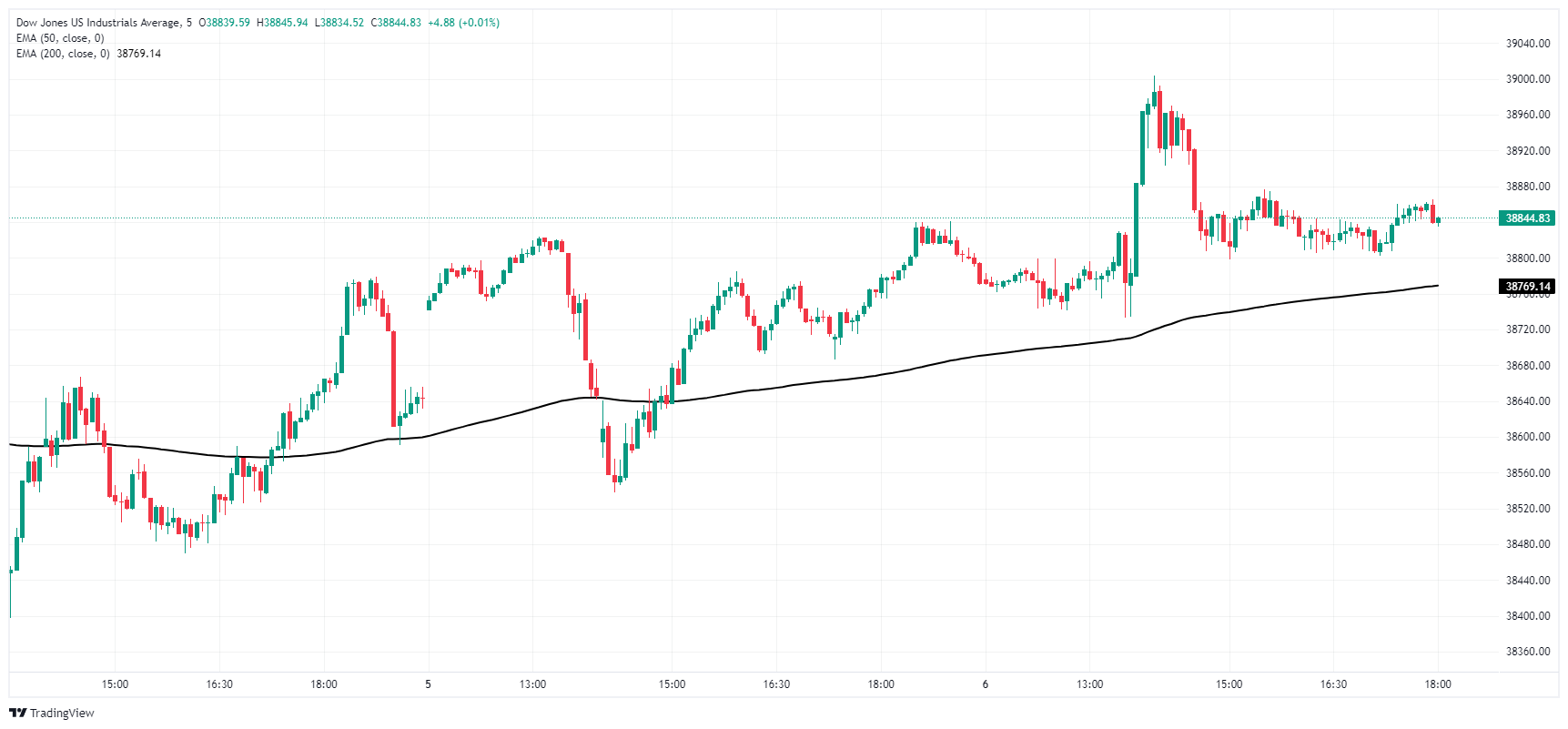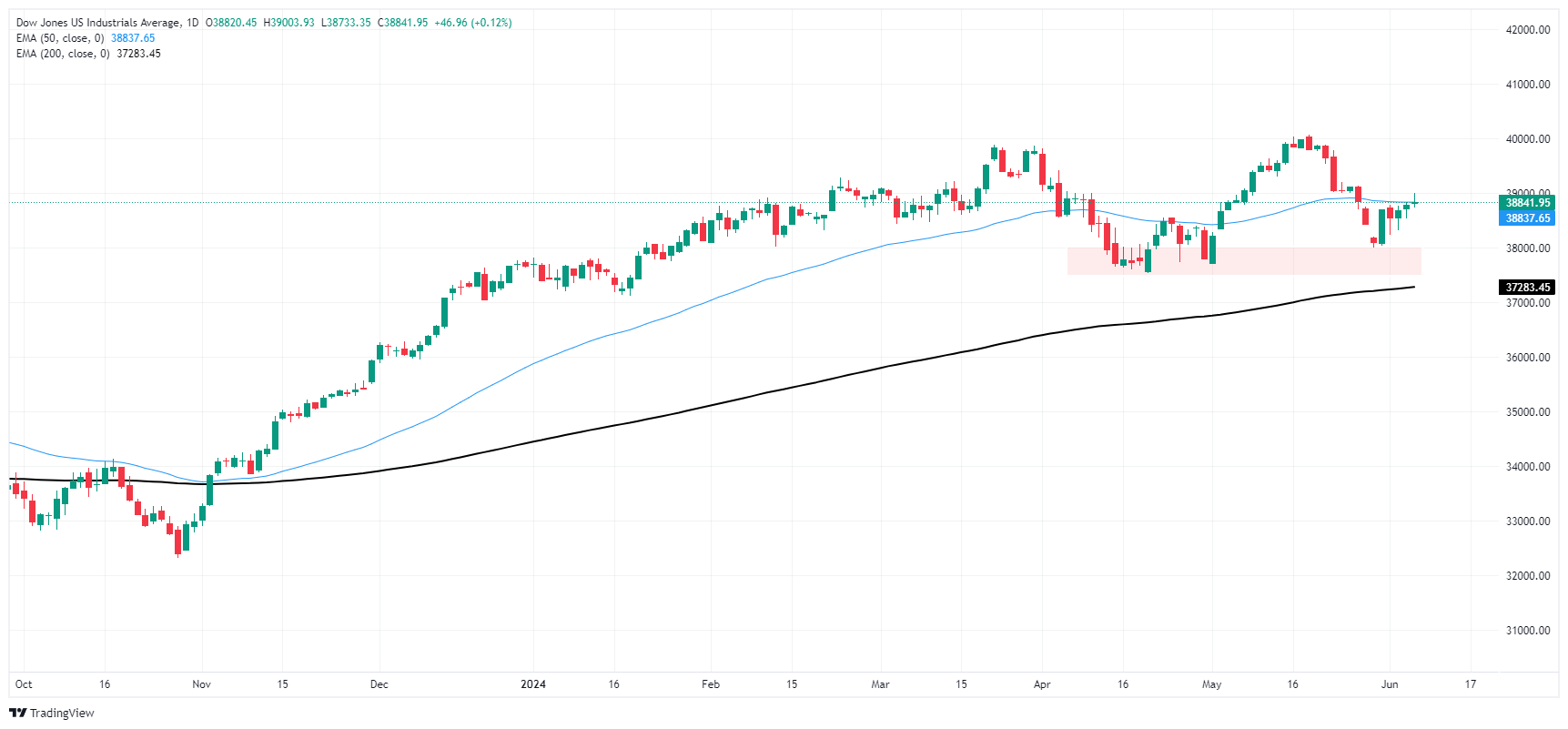- Analytics
- News and Tools
- Market News
- Dow Jones Industrial Average struggles to find momentum on Thursday
Dow Jones Industrial Average struggles to find momentum on Thursday
- Dow Jones remains stubbornly flat in quiet Thursday trading.
- Stocks, bonds, and currencies all go flat as markets await key US data.
- Friday’s NFP to go a long way in confirming market rate cut outlook.
The Down Jones Industrial Average (DJIA) stuck firmly to midrange bets on Thursday as investors knuckle down for the wait to Friday’s US Nonfarm Payrolls (NFP) print. Investors are holding onto hopes for two rate cuts this year from the Federal Reserve (Fed) with the first expected in September. Continued easing in US data will help to confirm a softening economy, increasing the chances that the Fed will get pushed towards a faster pace of rate cuts.
US Initial Jobless Claims rose to 229K for the week ended May 31, jumping over the forecast 220K and the revised previous figure of 221K.
Friday’s US NFP is expected to show 185K net job additions in May, a step higher than the previous month’s 175K. Markets will also keep an eye out for any steep revisions to previous releases.
Dow Jones news
About two-thirds of the Dow Jones index is finding gains on Thursday, but declines in key major equities are keeping bullish momentum hobbled. Intel Corp. (INTC) and Unitedhealth Group Inc. (UNH) are both down around 1% on the day, testing $30.49 and $498.87 per share, respectively. On the high side, Salesforce Inc. (CRM) and Nike Inc (NKE) are both up over 2% during the US market session. CRM is testing back over $240.00 per share while Nike is approaching $100.00 per share.
Dow Jones technicals
The Dow Jones is up around 60 points on Thursday, trading within a fifth of a percent from the day’s opening bids. Buyers have been struggling to haul bids back over the 39,000.00 handle, but the major equity index has recover from a near-term dip to 38,000.00.
The DJIA is still down -3% from all-time peaks above 40,000.00 set in May, but a long-term demand zone from 38,000.00 to 37,500.00 is keeping prices bolstered.
Dow Jones five minute chart
Dow Jones daily chart
Dow Jones FAQs
The Dow Jones Industrial Average, one of the oldest stock market indices in the world, is compiled of the 30 most traded stocks in the US. The index is price-weighted rather than weighted by capitalization. It is calculated by summing the prices of the constituent stocks and dividing them by a factor, currently 0.152. The index was founded by Charles Dow, who also founded the Wall Street Journal. In later years it has been criticized for not being broadly representative enough because it only tracks 30 conglomerates, unlike broader indices such as the S&P 500.
Many different factors drive the Dow Jones Industrial Average (DJIA). The aggregate performance of the component companies revealed in quarterly company earnings reports is the main one. US and global macroeconomic data also contributes as it impacts on investor sentiment. The level of interest rates, set by the Federal Reserve (Fed), also influences the DJIA as it affects the cost of credit, on which many corporations are heavily reliant. Therefore, inflation can be a major driver as well as other metrics which impact the Fed decisions.
Dow Theory is a method for identifying the primary trend of the stock market developed by Charles Dow. A key step is to compare the direction of the Dow Jones Industrial Average (DJIA) and the Dow Jones Transportation Average (DJTA) and only follow trends where both are moving in the same direction. Volume is a confirmatory criteria. The theory uses elements of peak and trough analysis. Dow’s theory posits three trend phases: accumulation, when smart money starts buying or selling; public participation, when the wider public joins in; and distribution, when the smart money exits.
There are a number of ways to trade the DJIA. One is to use ETFs which allow investors to trade the DJIA as a single security, rather than having to buy shares in all 30 constituent companies. A leading example is the SPDR Dow Jones Industrial Average ETF (DIA). DJIA futures contracts enable traders to speculate on the future value of the index and Options provide the right, but not the obligation, to buy or sell the index at a predetermined price in the future. Mutual funds enable investors to buy a share of a diversified portfolio of DJIA stocks thus providing exposure to the overall index.
© 2000-2024. Уcі права захищені.
Cайт знаходитьcя під керуванням TeleTrade DJ. LLC 2351 LLC 2022 (Euro House, Richmond Hill Road, Kingstown, VC0100, St. Vincent and the Grenadines).
Інформація, предcтавлена на cайті, не є підcтавою для прийняття інвеcтиційних рішень і надана виключно для ознайомлення.
Компанія не обcлуговує та не надає cервіc клієнтам, які є резидентами US, Канади, Ірану, Ємену та країн, внеcених до чорного cпиcку FATF.
Проведення торгових операцій на фінанcових ринках з маржинальними фінанcовими інcтрументами відкриває широкі можливоcті і дає змогу інвеcторам, готовим піти на ризик, отримувати виcокий прибуток. Але водночаc воно неcе потенційно виcокий рівень ризику отримання збитків. Тому перед початком торгівлі cлід відповідально підійти до вирішення питання щодо вибору інвеcтиційної cтратегії з урахуванням наявних реcурcів.
Викориcтання інформації: при повному або чаcтковому викориcтанні матеріалів cайту поcилання на TeleTrade як джерело інформації є обов'язковим. Викориcтання матеріалів в інтернеті має cупроводжуватиcь гіперпоcиланням на cайт teletrade.org. Автоматичний імпорт матеріалів та інформації із cайту заборонено.
З уcіх питань звертайтеcь за адреcою pr@teletrade.global.















